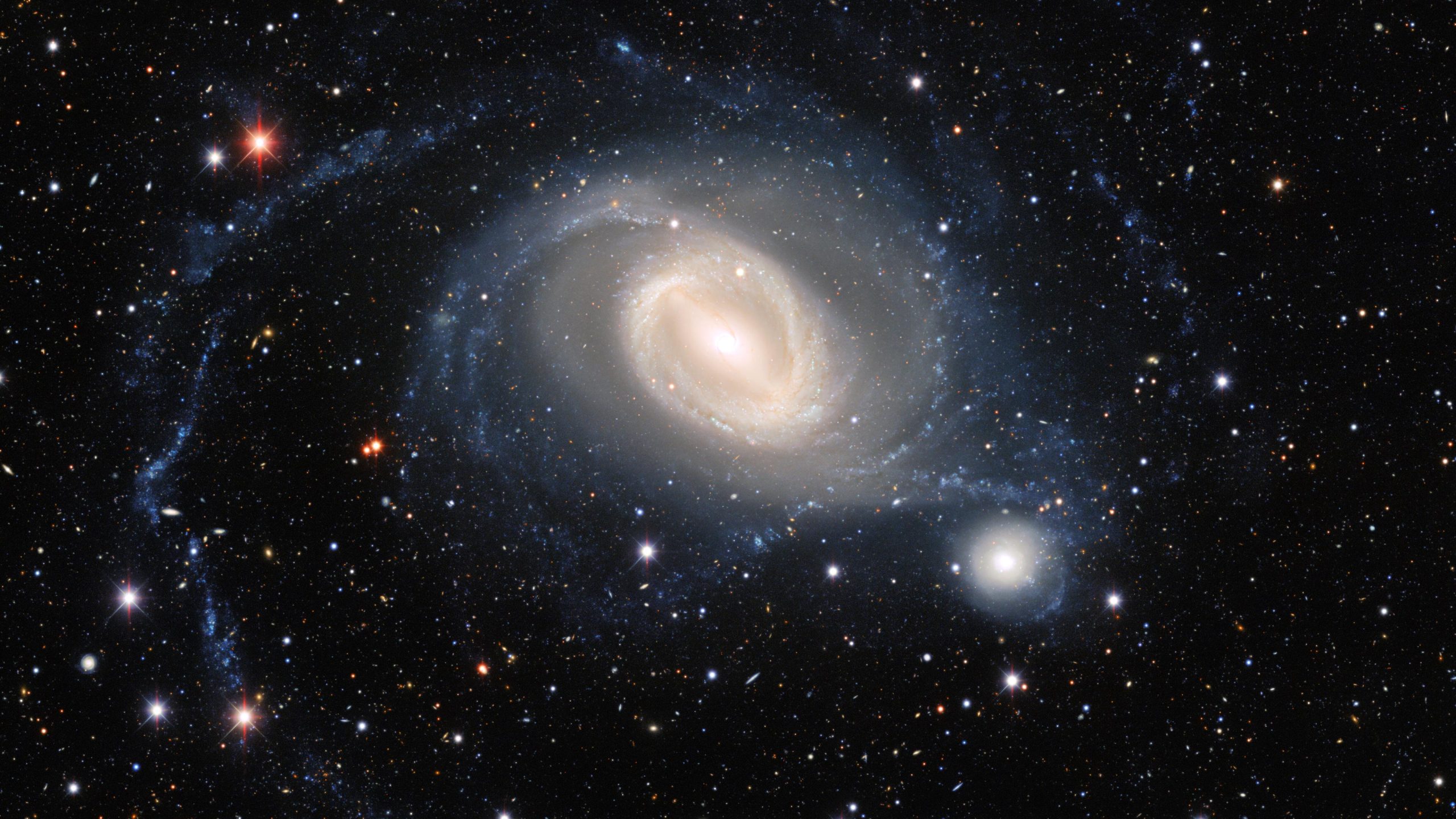NGC 1512와 NGC 1510 은하의 쌍방향 쌍은 NSF의 NOIRLab 프로그램인 Cerro Tololo Inter-American Observatory에 있는 Víctor M. Blanco 4미터 망원경의 최신 광시야 카메라인 Dark Energy Camera에서 촬영한 이 이미지의 중심 무대입니다. . NGC 1512는 4억 년 동안 더 작은 이웃 은하와 합병하는 과정에 있었고, 이 장기간의 상호 작용은 별 형성의 물결을 일으키고 두 은하를 왜곡했습니다. 출처: Dark Energy Survey/DOE/FNAL/DECam/CTIO/NOIRLab/NSF/AURA, 이미지 처리: TA Rector(University of Alaska Anchorage/NSF의 NOIRLab), J. Miller(Gemini Observatory/NSF의 NOIRLab), M. De Martin (NSF의 NOIRLab)
칠레에 있는 NSF의 NOIRLab에 있는 에너지 지원부의 암흑 에너지 카메라는 중력 쌍안경을 수행하는 한 쌍의 은하를 포착합니다.
대화형 은하 쌍 NGC 1512와 NGC 1510은 Cerro Tololo Inter-American의 Víctor M. Blanco 4미터 망원경으로 촬영한 최신 570메가픽셀 광시야 영상인 미국 에너지부의 암흑 에너지 카메라에서 촬영한 이 이미지의 중심을 차지합니다. Observatory, NSF NOIRLab의 제휴 프로그램입니다. NGC 1512는 4억 년 동안 더 작은 이웃 은하와 합병하는 과정에 있었고, 이 장기간의 상호작용은 별 형성의 물결을 일으켰습니다.
이 관측에서 장벽나선은하 NGC 1512(왼쪽)와 작은 은하 NGC 1510(기사 상단 이미지)은 4미터 Víctor M. Blanco 망원경으로 포착했습니다. NGC 1512의 복잡한 내부 구조를 드러내는 것 외에도 이 사진은 은하의 희미한 바깥 덩굴손이 확장되어 작은 동반자를 둘러싸고 있는 것처럼 보이는 것을 보여줍니다. 두 은하를 연결하는 별빛의 흐름은 4억 년 동안 지속된 호화롭고 우아한 연결인 두 은하 사이의 중력 상호 작용의 증거입니다. NGC 1512와 NGC 1510 사이의 중력 상호작용은 두 은하의 별 형성 속도와 모양 왜곡에 영향을 미쳤다. 마지막으로 NGC 1512와 NGC 1510은 하나의 더 큰 은하로 합쳐질 것입니다. 이는 은하 진화의 긴 예입니다.

NGC 1512 이미지의 넓은 자르기 출처: Dark Energy Survey/DOE/FNAL/DECam/CTIO/NOIRLab/NSF/AURA, 이미지 처리: TA Rector(University of Alaska Anchorage/NSF의 NOIRLab), J. Miller(Gemini Observatory/NSF’s) NOIRLab) , M. de Martin (NSF의 NOIRLab)
이 상호 작용하는 은하는 남반구에서 별자리 Horologium 방향에 위치하고 있으며 지구에서 약 6천만 광년 떨어져 있습니다. 이 관측의 넓은 시야는 얽힌 은하뿐만 아니라 별이 빛나는 주변을 보여줍니다. 프레임은 내부에 밝은 전면 별들로 가득 차 있습니다.[{” attribute=””>Milky Way and is set against a backdrop of even more distant galaxies.
The image was taken with one of the highest-performance wide-field imaging instruments in the world, the Dark Energy Camera (DECam). This instrument is perched atop the Víctor M. Blanco 4-meter Telescope and its vantage point allows it to collect starlight reflected by the telescope’s 4-meter-wide (13-foot-wide) mirror, a massive, aluminum-coated, and precisely shaped piece of glass roughly the weight of a semi truck. After passing through the optical innards of DECam — including a corrective lens nearly a meter (3.3 feet) across — starlight is captured by a grid of 62 charge-coupled devices (CCDs). These CCDs are similar to the sensors found in ordinary digital cameras but are far more sensitive, and allow the instrument to create detailed images of faint astronomical objects such as NGC 1512 and NGC 1510.

An even wider crop of the NGC 1512 image. Credit: Dark Energy Survey/DOE/FNAL/DECam/CTIO/NOIRLab/NSF/AURA, Image processing: T.A. Rector (University of Alaska Anchorage/NSF’s NOIRLab), J. Miller (Gemini Observatory/NSF’s NOIRLab), M. Zamani & D. de Martin (NSF’s NOIRLab)
Large astronomical instruments such as DECam are custom-built masterpieces of optical engineering, requiring enormous effort from astronomers, engineers, and technicians before the first images can be captured. Funded by the US Department of Energy (DOE) with contributions from international partners, DECam was built and tested at DOE’s Fermilab, where scientists and engineers built a “telescope simulator” — a replica of the upper segments of the Víctor M. Blanco 4-meter Telescope — that allowed them to thoroughly test DECam before shipping it to Cerro Tololo in Chile.
DECam은 7개국 25개 기관의 400명 이상의 과학자가 참여하는 6년(2013-2019) 관측 캠페인인 DES(암흑 에너지 조사)를 수행하기 위해 설립되었습니다. 이 국제 협력 노력은 수억 개의 은하를 지도화하고, 수천 개의 초신성을 발견하고, 우주 구조의 미묘한 패턴을 발견하기 위해 시작되었습니다. 이 모든 것은 우주 팽창을 가속화하는 신비한 암흑 에너지에 대해 매우 필요한 세부 정보를 제공하기 위한 것입니다. 오늘날 DECam은 최첨단 과학의 유산을 계속하기 위해 전 세계 학자들이 소프트웨어에 여전히 사용하고 있습니다.

“경순은 통찰력 있고 사악한 사상가로, 다양한 음악 장르에 깊은 지식을 가지고 있습니다. 힙스터 문화와 자연스럽게 어우러지는 그의 스타일은 독특합니다. 그는 베이컨을 좋아하며, 인터넷 세계에서도 활발한 활동을 보여줍니다. 그의 내성적인 성격은 그의 글에서도 잘 드러납니다.”
